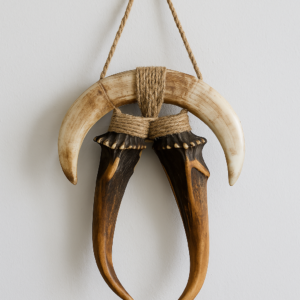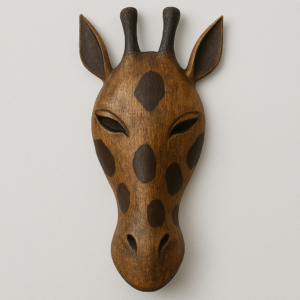“The Golden Seer of the Sahel,” translated into Swahili as ““Wamaji Wa Dhahabu,” is a mesmerizing ritual mask that radiates royalty, divination, and transcendent wisdom. Hailing stylistically from the Dogon or Bamana traditions of Mali and the broader Sahelian region of West Africa, this elongated ceremonial mask is a regal symbol of spiritual elevation and ancestral communication. Richly adorned in textured gold tones with cobalt blue accents, it embodies the dual essence of earthly authority and cosmic vision.
From the first glance, the mask speaks of nobility and mysticism. Its most striking feature is its towering, narrow form, which is symbolic in many West African cultures of one who is close to the heavens. Elongated masks are often associated with deities, sky spirits, and elders who have passed into the realm of the ancestors. The verticality of Wamaji Wa Dhahabu is not merely aesthetic; it represents spiritual ascension and the journey from the physical world to higher knowledge.
The eyes—narrow, carved into deep-set recesses—are painted a vivid blue, framed by angular brows that suggest a state of deep trance. The blue pigment is not just decorative. In African color symbolism, blue represents truth, sky, the spirit realm, and healing. These eyes, hollow yet alive with hue, are crafted to peer into dimensions unseen, accessing ancestral wisdom and prophetic visions.
A pronounced nose and lips follow the same symmetry of vertical elegance. The lips, also painted blue, imply the sacred power of spoken word—possibly invocations or incantations. In many African traditions, only spiritual leaders, griots, or elders were allowed to speak while wearing such masks, making every syllable a vessel of ancestral authority. Tiny hints of red pigment at the nostrils and ear tips suggest bloodlines, life force, or connection to the rituals of sacrifice and offering.
Intricate carvings cover the entire facial plane—geometric motifs, etchings, and dotted patterns forming a lattice of coded spiritual language. These patterns could represent everything from clan affiliations and divine hierarchies to protective sigils and cosmograms. Each mark is deliberate, each angle a reference to an oral tradition, a dance, a myth encoded in wood and pigment.
Crowning the mask are two upright horn-like structures or stylized animal ears, reminiscent of the Tji Wara headdresses from the Bamana people, used to honor the antelope spirit of agricultural invention. These forms could represent a synthesis of animal and ancestral spirits—expressing a totemic link between human, nature, and divine. At the center of the crest is a serrated ridge, possibly symbolizing the spine of a spiritual guide or the rise and fall of cosmic forces.
The golden-bronze coloration dominates the overall presence of the mask, giving it a metallic sheen. This was likely achieved using natural pigments, burnishing techniques, or gilded clay finishes. In traditional African culture, gold or bronze hues signify wealth, sunlight, divine favor, and political influence. The metallic finish enhances the mask’s sacred authority, implying its usage by elite spiritual leaders or royal ceremonial figures.
While this piece is sculpturally complete on its own, in performance it would have been paired with long robes, fiber headdresses, or even full-body regalia. The dancer or seer wearing it might perform during rites of passage, ancestral consultations, agricultural blessings, or community judgments. The mask’s ability to conceal identity is critical—allowing the wearer to become a vessel, not a personality. This transformation is the essence of mask ritual—to step aside and let the spirit speak.
As a modern display object, Wamaji Wa Dhahabu retains all the charisma and narrative depth of its origins. It stands as a statement of resilience, dignity, and the sacred nature of African artistry. Whether mounted in a museum, cultural center, or private collector’s space, it commands attention—not with noise, but with a regal silence that demands reverence.
Its balanced proportions and sacred geometry appeal to designers and spiritual aesthetes alike. Its rich texture and luminous presence give it life across light and shadow. For those seeking objects that hold both power and mystery, Wamaji Wa Dhahabu is not just a mask. It is a gatekeeper to ancestral echoes, a monument to golden truths whispered through generations.





Reviews
There are no reviews yet.